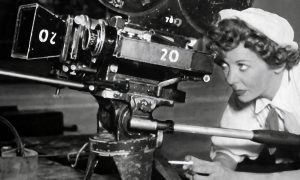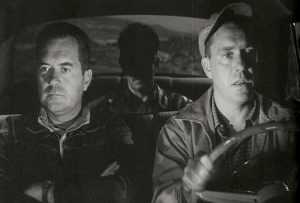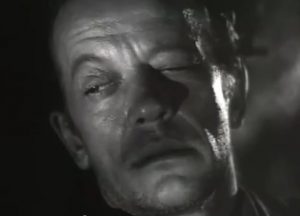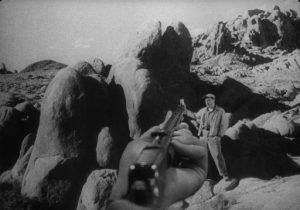In the first few weeks into the new year of 1951, William E. Cook Jr., took up residence on the headlines for the largest manhunt in United States history. Bringing a whole new kind of criminal mastery to the screen in March of 1953, RKO Radio Pictures and The Filmmakers Inc., served up a critically acclaimed film noir based on the true story of Cook’s mass killing spree. That film was The Hitch-Hiker, directed by actress-turned-filmmaker Ida Lupino. While women usually served only as femmes fatales in the noir genre , the only female role in this story took the director’s chair.

Ida Lupino eyes up a shot.
Groomed as a potential replacement for a Bette Davis type at Warner Brothers, Lupino projected a wounded, soulful toughness during her prime as an actress, even in the most savorless films. Her starring roles comprised of the innocent yet provocative girl next door and in bit parts in such titles as Money for Speed (1933), Prince of Arcadia (1933) and High Finance (1933). In her initiation to Hollywood pictures, Lupino had been hailed as “the English Jean Harlow.” When she had tired of playing the modest girl, she sought more challenging roles in the film industry. After picking up the fine points of direction by observing the likes of Raoul Walsh (White Heat, 1949) and William Wellman, (Public Enemy, 1931) she formed her first independent production company, Emerald Productions.

Ida Lupino filming The Hitch-Hiker.
With her company later renamed The Filmmakers Production Co. during the years between 1949 to 1953, Lupino wrote, co-wrote and directed eight successful feature films. These titles included Outrage (1950), They Won’t Forget (1937) and Hard, Fast and Beautiful (1951). Unlike most film melodramas of the era, Lupino’s work aimed to convey the most controversial sides of the human condition: “brutal repercussions of sexuality, independence, and dependence are what thrusts a great story” (Lupino, 1953). American filmmaker, poet, author, and film historian Ally Acker claimed in 1991 that Lupino “chose controversial, socially conscious issues for the themes of her movies: rape, bigamy, polio, unwed motherhood.”
One such film noir, The Hitch-Hiker (1953), was the most successful film in her career. It tells the story, based on a true-life account, of a cold-blooded, sadistic, psychotic mass murderer and kidnapper William Cook, alternatively identified in the film as Emmett Meyers played by William Talman. The Hitch-Hikers release was during the height of the McCarthy “Red Scare” era and reflected U.S. paranoia about strangers during the Cold War in the years 1940 through the mid 1950’s. Without any known motivation to commit these crimes, Cook murdered six people, including children and abducted four others, while he thumbed his way across the mid-west and into Mexico. Staying true to her ambitious subject matter, Lupino went above and beyond and recovered the circumstances of the story by actual survivors of the event.

Low-key lighting used in The Hitch-Hiker.
The film displays noir techniques, highlighted by dark shadows and the heightened sense of gritty realism that despite being low budget, packs a punch in chilling sequences. In the absence of blood and gore, the atmosphere cautions violence and hyper realistic sense of claustrophobia. The majority of the film takes place inside the car of two unsuspecting victims Roy Collins (Edmond O’Brien) and Gilbert Bowen (Frank Lovejoy) who have just picked up the lonesome hitchhiker. Moments later, it is revealed to them that they have just picked up the man that pledges that he would be the last man they will ever see, once they get to his destination.
The Hitch-Hiker clutches the incredulous victims in a vortex of threats, uncertainty, and intimidation as the story progresses. The harsh pacing, despotic close ups, and the mercilessness effects are achieved by the use of the composition and contrast of the location the vehicle is traveling. Not only are the victims trapped in a vehicle in which there is no escape, they are traveling in the vast deserts of California. The vast desert gives the illusion that there are ample places to run, comparatively to that of which “dreams are made of”, in John Huston’s 1941 film, The Maltese Falcon. The characters can taste freedom, but it’s deemed unattainable. Ida Lupino’s writing strips away the human basic instinct: fight or flight, by highlighting the mass killer’s one discernible accommodating trait: Myers has a bum eye which cannot be closed, begging the question, is he wake or is he asleep?

William Tallman offers a chilling performance as the killer.
In a terrifying scene, the victims are forced to partake in a little target practice. One holds a cigarette pack outward while the other is forced to shoot the pack out of the others hand. This scene just may have inspired a similar scene in Michael Caton-Jones’s 1997 film, The Jackal. The victims meant only to take the weekend down to Mexico, breaking the dull life cycle and cast a line in the abundant fishing holes that had once brought them sanctuary. Under circumstances that warrant high fueled anxiety from its audience, The Hitchhiker frolics in the themes of moral polarization (good vs. bad), triumphing over evil, domination, man vs. man, sanity, survival, and will power.


The Jackal pays homage to The Hitch-Hiker.
In the mass male-dominated industry, Ida Lupino established that she wasn’t just the girl next door or damsel in distress. She produced films that illustrated an awe-inspiring masculine gauntlet experience that fits right into film noir. The Hitch-Hiker propelled the ideas already established in film noir, focusing on anxieties and insecurities in the human condition. That Lupino’s film did so in the golden age of male-dominated Hollywood is an even bigger accomplishment.

Recent Comments